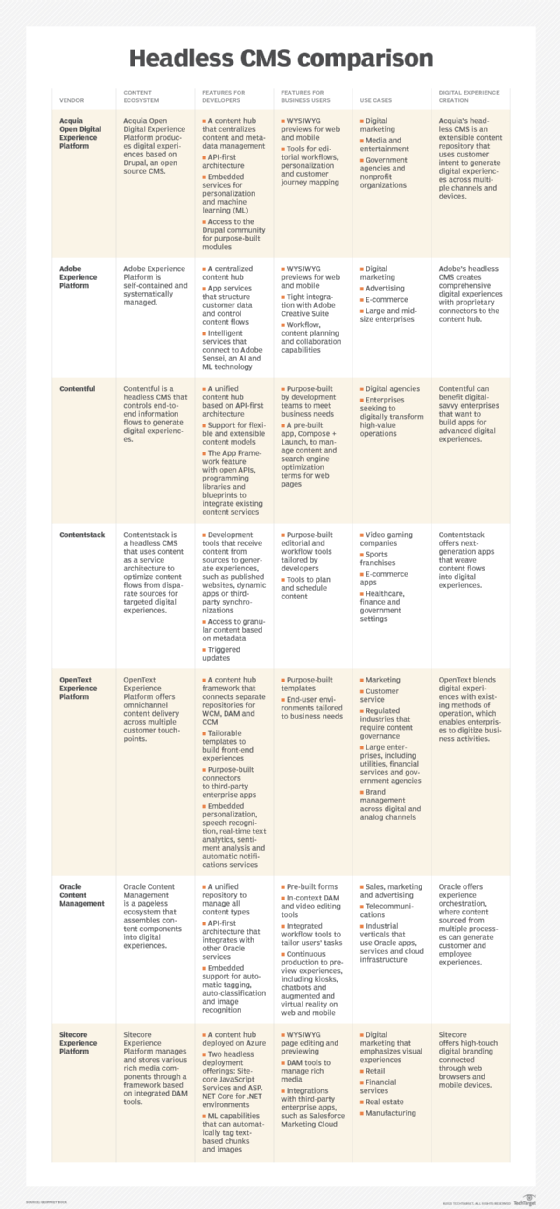
Getty Images/iStockphoto
Compare 7 headless CMS offerings and their key differences
This headless CMS comparison chart highlights five key differences, including use cases, features and more, between the top headless CMS platforms in the industry.
As organizations launch innovative digital experiences, many adopt a headless content management system -- or CMS -- to manage various types of content that fuel their operations.
Organizations no longer only publish text and rich media to websites and mobile devices. Instead, they aim to develop content-powered applications. A headless CMS offers the computational framework to create these apps and weave disparate content streams into compelling digital experiences.
How do headless CMSes work?
Vendors design their headless CMS offerings to simplify how app developers build next-generation apps. Vendors also rely on RESTful and open APIs to interconnect related services accessed through cloud environments. At the same time, a headless CMS enables business users to maintain content needed for digital experiences. These CMSes also let users preview these experiences across devices and delivery channels. Yet, headless CMSes come with trade-offs. Organizations may struggle to balance what developers want and what business users need.
Some organizations adopt digital experience platforms, which include headless capabilities and separate individual back-end repositories from how platforms generate front-end experiences. In addition, some vendors produce native headless CMS offerings and design the CMS's underlying repositories, APIs and services to support cloud architectures.
Overview of headless CMS vendors
The headless CMS comparison chart provides a side-by-side view of seven headless CMS offerings in alphabetical order.
Acquia Open Digital Experience Platform. Acquia uses Drupal -- version 8.2 or later -- for its API-first headless CMS platform. This means the platform can access content components through RESTful APIs.
Adobe Experience Platform. Adobe's headless CMS platform offers programmatic access to text and rich media managed within its content repository.
Contentful. With its native headless platform, Contentful offers an underlying repository and open APIs to help developers integrate existing content services and quickly build digital experiences. Contentful is also rolling out prebuilt components for repeatable tasks.
Contentstack. As a native headless platform, Contentstack offers APIs and prepackaged components to develop interactive digital experiences with low-code or no-code building techniques.
OpenText Experience Platform. A stalwart CMS vendor, OpenText's headless platform offers APIs to connect to content hubs for web content management (WCM), digital asset management (DAM) and customer communications management (CCM).
Oracle Content Management. With its expertise as an enterprise software vendor, Oracle's headless CMS platform offers a native headless product designed for experience orchestration.
Sitecore Experience Platform. Sitecore's headless CMS offers a cloud-native content hub and APIs. The platform is optimized for rich media assets and designed to structure the flow of content across various departments within an organization.

Highlighting the headless CMS comparison chart
Organizations must consider headless CMS products from three perspectives: what they offer developers who build content-powered apps, what they offer business users who need the apps to do their jobs, and what they offer organizations that want to benefit from their investments. Organizations must also consider their content ecosystems and how they want to create digital experiences.
Below are the five comparative criteria.
- Content ecosystem. The content ecosystem summarizes the range of content resources incorporated into a CMS offering.
- Features for developers. A headless CMS offers app developers a range of APIs, components and features to develop content-powered experiences.
- Features for business users. Business users expect easy-to-use capabilities to create, update and manage different types of content and preview the published results.
- Use cases. Use cases highlight the business situations where organizations could benefit most from headless CMS offerings.
- Digital experience creation. The way each headless CMS creates digital experiences showcases the competitive appeal of a vendor's offering.








